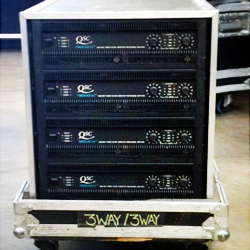
Now, to be honest, manufacturers don’t go through this every time they measure power as part of a model’s qualification for published specs. Most, though, have put the amp design through similar endurance testing as a part of the design process and are thus aware of whether the amp can pass or not.
But if it can’t pass the preconditioning requirements, it can’t have an FTC spec. That’s why all but a very few amps have EIA specs, but not FTC specs, at 2 ohms per channel, even though they may be commonly used at 2 ohms.
Like the EIA spec, the maximum power point in the FTC spec is defined as where the THD reaches a specified level. Typical points chosen by manufacturers are 0.025, 0.03, 0.05, 0.1 percent, and so on.
However, the THD spec chosen has to be valid from 250 milliwatts, where any crossover distortion would be prominent, up to the rated power level. FTC is definitely a rigorous and demanding power measurement standard, and that may be a shortcoming because of the way it cannot describe 2-ohm performance on most amps.
Q.) I’ve got a 2400W amp, but its manual says it draws only 12 amperes at 120V. Who are they kidding?
A.) No one, and here’s why. You need your amps’ full power for peaks and large transients. Fortunately for your amps and the AC power system, these peaks and transients don’t last long.
An amp with a good power reservoir can briefly put out more power than it draws from the AC. But averaging the power over time, even a period as short as several seconds, shows that the actual power put out is far below the peaks.
This is called crest factor, and depending on the kind of music or other program material, it can run as high as 20 dB. That means although the peaks are hitting the clipping point at 2400W, the average power put out is only about 24W.
Compressed music has a lower crest factor, and light clipping will bring up the average power a bit. But even if, say, the bass player is using a compressor and hits a long, loud note, the attack of the note will still be several decibels higher than the sustain. If you’ve got enough power for the attack, the rest of the note will be a piece of cake.
Most safety agencies use pink noise at 1/8th of full power (corresponding to an effective crest factor of 9 dB) as equivalent to the typical maximum music level that won’t cause objectionable clipping. Safety agencies aren’t known for daring and permissive over- or understatement, so current draw ratings measured at 1/8th power are pretty safe to use for most normal operation.
Bob Lee serves as technical communications developer with QSC. He was honored at the 137th Convention of the Audio Engineering Society last year with the AES Fellowship Award. The award is presented to an AES member who has rendered conspicuous service, or is recognized to have made a valuable contribution to the advancement in or dissemination of knowledge of audio engineering or in the promotion of its application in practice.
